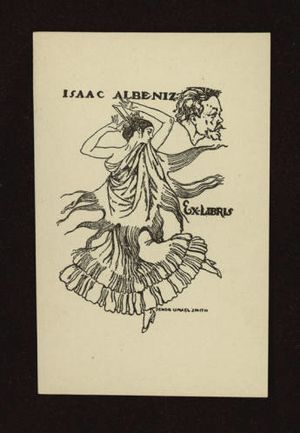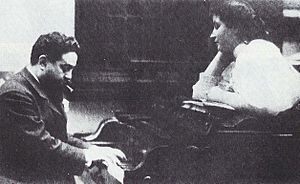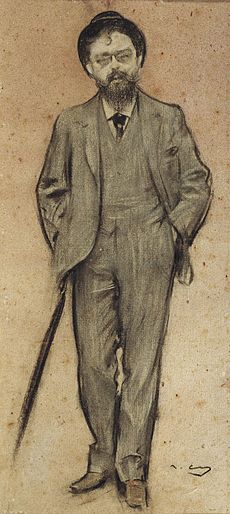Isaac Albéniz facts for kids
Quick facts for kids
Isaac Albéniz
|
|
|---|---|

Albéniz at the piano, 1901
|
|
| Born |
Isaac Manuel Francisco Albéniz y Pascual
29 May 1860 |
| Died | 18 May 1909 (aged 48) Cambo-les-Bains, France
|
| Resting place | Montjuïc Cemetery |
| Occupation | pianist, Composer |
| Years active | 1864−1909 |
Isaac Manuel Francisco Albéniz y Pascual (born May 29, 1860 – died May 18, 1909) was a famous Spanish pianist, composer, and conductor. He was known for being a virtuoso, meaning he was incredibly skilled at playing the piano. Albéniz is one of the most important composers from the time after the Romantic era.
He greatly influenced other musicians of his time and those who came after him. Albéniz is best known for his piano pieces that use ideas from Spanish folk music. Many of his pieces, like Asturias (Leyenda) and Sevilla, are now very popular for classical guitar, even though he wrote them for piano. His personal papers are kept in places like the Library of Catalonia.
Contents
A Young Musical Genius
Isaac Albéniz was born in Camprodon, Spain. His father, Ángel Albéniz, worked for customs. Isaac was a true child prodigy, which means he was a super talented kid. He gave his first performance when he was only four years old!
When he was seven, he tried to join the Conservatoire de Paris, a famous music school. But they didn't let him in because he was too young. By the time he was 12, he had tried to run away from home many times.
His career as a concert performer started when he was nine. His father took Isaac and his sister, Clementina, on tours across northern Spain. There's a popular story that Isaac ran away at age twelve and traveled the world by himself. He supposedly went to Buenos Aires, Cuba, and the United States, giving concerts.
While it's true that Albéniz traveled a lot as a performer, he was actually with his father. His father, being a customs agent, traveled often for work. This explains how Isaac performed in so many different places.
In 1876, after a short time at the Leipzig Conservatory, he went to study at the Royal Conservatory of Brussels. He got a special grant from King Alfonso's secretary, Guillermo Morphy. Count Morphy thought highly of Albéniz. Albéniz later dedicated his piece Sevilla to Morphy's wife.
In 1880, Albéniz traveled to Budapest, Hungary, hoping to study with the famous composer Franz Liszt. But Liszt was in Germany at the time.
Discovering Spanish Music
In 1883, Albéniz met a teacher and composer named Felip Pedrell. Pedrell was a very important person in creating Spanish national music. He encouraged Albéniz to write music that sounded truly Spanish.
One example is the Chants d'Espagne suite. The first part of this suite, called "Prelude," is now known as Asturias (Leyenda). It's a very popular piece for classical guitar, even though Albéniz wrote it for piano. Many of his other works were also changed for guitar by Francisco Tárrega.
At the 1888 Barcelona Universal Exposition, a piano company called Érard sponsored 20 concerts. All of these concerts featured Albéniz's music.

Albéniz's best years for concerts were from 1889 to 1892. During this time, he toured all over Europe. In the 1890s, he lived in London and Paris. In London, he wrote some musical comedies. These caught the attention of a rich man named Francis Money-Coutts, 5th Baron Latymer.
Money-Coutts asked Albéniz to write operas and even provided the stories for them. One opera was Henry Clifford. He also planned a group of three operas about King Arthur. The first one, Merlin, was completed and has been performed recently. Albéniz never finished the second opera, Lancelot, and never started the third, Guinevere.
Later Years and Masterpieces
Around 1900, Albéniz became ill with a kidney disease. He then focused on writing piano music again. Between 1905 and 1908, he created his most famous work, Iberia. This is a collection of twelve piano pieces that are like musical "impressions."
In 1883, Albéniz married his student, Rosina Jordana. They had two children who grew up: Laura, who became a painter, and Alfonso, who played soccer for Real Madrid before becoming a diplomat. Two other children died when they were very young.
Albéniz passed away from his kidney disease on May 18, 1909, in France. He was only 48 years old. Just a few weeks before he died, the French government gave him the Legion of Honour. This is France's highest award. He is buried in the Montjuïc Cemetery in Barcelona.
Albéniz's Music
Early Musical Styles
Albéniz's first pieces were mostly "salon style" music. This was music meant for small gatherings, not big concert halls. His very first published piece, Marcha Militar, came out in 1868. Some of his earlier works are now lost.
He continued to compose in traditional styles until the mid-1880s. He also wrote at least five zarzuelas, which are Spanish musical plays. Most of these are also lost today.
Spanish Influence in Music
In the late 1880s, Albéniz's music started to show a strong Spanish influence. This happened after he met Felipe Pedrell in 1883. Pedrell was a key person in developing Spanish national music. He helped Albéniz see the amazing qualities in Spanish music.
Pedrell inspired Albéniz to create truly Spanish pieces, like the Suite española, Op. 47. This suite is known for its beautiful, detailed melodies and sudden changes in volume.
After he got married, Albéniz lived in Madrid, Spain. He wrote a lot of music in a short time there. By 1886, he had composed over 50 piano pieces. These pieces were very popular at his many concerts.
Later Masterpieces
Albéniz's greatest work, Iberia, was written in his final years in France. But many of his works before Iberia are also very famous. The five pieces in Chants d'Espagne (Songs of Spain), published in 1892, show his developing musical ideas.
This period also includes his operas: Merlin, Henry Clifford, and Pepita Jiménez. His orchestral works from this time include Spanish Rhapsody (1887) and Catalonia (1899).
Albéniz's Lasting Impact
Albéniz was one of the most important composers of his time. He had a huge impact on other composers and on the future of Spanish music. He spent a lot of time in France and became friends with many French composers. His way of composing and his use of harmonies influenced younger composers like Claude Debussy and Maurice Ravel.
As a conductor, performer, and composer, he helped Spanish music become more known around the world. He also encouraged Spanish musicians in his own country.
Many of Albéniz's piano pieces have become important for classical guitar players. Guitarists like Francisco Tárrega and Miguel Llobet changed them for the guitar. Asturias (Leyenda) is especially famous on the guitar. Other popular pieces for guitar include Granada, Sevilla, and Cadiz.
Albéniz's music has even appeared in popular culture. The Doors used "Asturias" in their song "Spanish Caravan." Iron Maiden's song "To Tame a Land" also uses the introduction of "Asturias." More recently, a guitar version of Granada was used in Woody Allen's 2008 film Vicky Cristina Barcelona. The theme from Asturias was also used in the 2008 horror film Mirrors and the Netflix TV show Godless.
In 1997, the Fundación Isaac Albéniz was created. This foundation helps promote Spanish music and musicians. It also serves as a research center for Albéniz and Spanish music.
A street in Quito, Ecuador, is named after him.
In Film
A movie about Isaac Albéniz's life, called Albéniz, was made in Argentina in 1947.
Images for kids
-
Albéniz, a drawing by Ramon Casas (MNAC)
See also
 In Spanish: Isaac Albéniz para niños
In Spanish: Isaac Albéniz para niños







